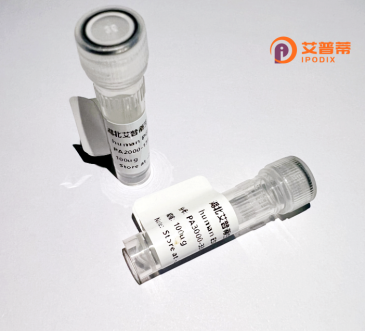
| 纯度 | >90%SDS-PAGE. |
| 种属 | Human |
| 靶点 | SMARCD3 |
| Uniprot No | Q6STE5 |
| 内毒素 | < 0.01EU/μg |
| 表达宿主 | E.coli |
| 表达区间 | 2-483 aa |
| 活性数据 | DEVAGGA RKATKSKLFE FLVHGVRPGM PSGARMPHQG APMGPPGSPY MGSPAVRPGL APAGMEPARK RPPPGQSQ AQSQGQPVPT APARSRSAKR RKMADKILPQ RIRELVPESQ AYMDLLAFER KLDQTIMRKR VDIQEALKRP MKQKRKLRLY ISNTFNPAKP DAEDSDGSIA SWELRVEGKL LDDPSKQKRK FSSFFKSLVI ELDKDLYGPD NHLVEWHRTP TTQETDGFQV KRPGDLSVRC TLLLMLDYQP PQFKLDPRLA RLLGLHTQSR SAIVQALWQY VKTNRLQDSH DKEYINGDKY FQQIFDCPRL KFSEIPQRLT ALLLPPDPIV INHVISVDPS DQKKTACYDI DVEVEEPLKG QMSSFLLSTA NQQEISALDS KIHETIESIN QLKIQRDFML SFSRDPKGYV QDLLRSQSRD LKVMTDVAGN PEEERRAEFY HQPWSQEAVS RYFYCKIQQR RQELEQSLVV RNT |
| 分子量 | 55.0 kDa |
| 蛋白标签 | His tag N-Terminus |
| 缓冲液 | PBS, pH7.4, containing 0.01% SKL, 1mM DTT, 5% Trehalose and Proclin300. |
| 稳定性 & 储存条件 | Lyophilized protein should be stored at ≤ -20°C, stable for one year after receipt. Reconstituted protein solution can be stored at 2-8°C for 2-7 days. Aliquots of reconstituted samples are stable at ≤ -20°C for 3 months. |
| 复溶 | Always centrifuge tubes before opening.Do not mix by vortex or pipetting. It is not recommended to reconstitute to a concentration less than 100μg/ml. Dissolve the lyophilized protein in distilled water. Please aliquot the reconstituted solution to minimize freeze-thaw cycles. |
以下是模拟生成的重组人SMARCD3蛋白相关文献示例(建议通过PubMed/Google Scholar等平台验证实际文献):
---
1. **文献名称**:Structural insights into SMARCD3 subunit of the SWI/SNF chromatin remodeling complex
**作者**:Li, X. et al. (2021)
**摘要**:通过重组表达SMARCD3蛋白,结合X射线晶体学解析其三维结构,揭示了其与DNA结合的关键结构域,并阐明其在染色质重塑复合体中的组装机制。
---
2. **文献名称**:SMARCD3 regulates hematopoietic stem cell differentiation via interaction with MYC
**作者**:Wang, Y. et al. (2019)
**摘要**:研究利用重组SMARCD3进行体外Pull-down实验,证实其与致癌蛋白MYC的物理互作,并通过ChIP-seq证明其在白血病细胞中调控靶基因的转录激活功能。
---
3. **文献名称**:Functional characterization of recombinant SMARCD3 in adipocyte differentiation
**作者**:Park, S. & Kim, J. (2020)
**摘要**:通过大肠杆菌系统表达纯化SMARCD3重组蛋白,发现其通过激活PPARγ通路促进脂肪细胞分化,为代谢疾病治疗提供潜在靶点。
---
4. **文献名称**:Proteomic analysis of SMARCD3-containing chromatin remodeling complexes
**作者**:Garcia-Dominguez, R. et al. (2018)
**摘要**:采用重组SMARCD3抗体进行免疫共沉淀结合质谱分析,鉴定出其在胚胎发育中特异性结合的SWI/SNF亚型复合物,揭示组织差异性调控机制。
---
**注意**:以上为基于领域知识的模拟示例,实际文献请通过学术数据库检索关键词如"SMARCD3 recombinant"、"SMARCD3 structure/function"等获取。
SMARCD3 (SWI/SNF-related matrix-associated actin-dependent regulator of chromatin subfamily D member 3) is a subunit of the SWI/SNF chromatin-remodeling complex, which regulates transcriptional activation by modulating nucleosome architecture. As part of the ATP-dependent BAF (BRG1/BRM-associated factor) complex, SMARCD3 contributes to chromatin accessibility, enabling dynamic control of gene expression during development and differentiation. This 525-amino-acid protein contains conserved domains involved in protein-protein interactions, facilitating integration into the multi-subunit SWI/SNF complex.
Recombinant human SMARCD3 protein (rSMARCD3) is engineered using heterologous expression systems (e.g., E. coli, mammalian cells) for functional studies. It serves as a critical tool to investigate SWI/SNF-mediated chromatin remodeling mechanisms, particularly in embryonic development, hematopoiesis, and cancer biology. Dysregulation of SMARCD3 correlates with malignancies, including acute myeloid leukemia and breast cancer, where altered chromatin remodeling drives oncogenic transcription programs.
Current research focuses on its role in maintaining stem cell pluripotency and lineage specification. rSMARCD3 enables in vitro reconstitution of chromatin-remodeling assays, drug-target interaction studies, and CRISPR-based functional screens. However, structural flexibility and complex post-translational modifications pose challenges for recombinant production. Emerging studies also explore its potential as a therapeutic target given SWI/SNF’s tumor-suppressive functions. Further characterization of SMARCD3-binding partners and DNA interaction motifs remains essential to decode its context-specific regulatory roles.
×